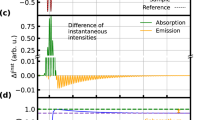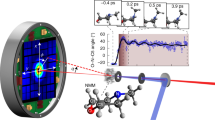Abstract
Echoes occur in many physical systems, typically in inhomogeneously broadened ensembles of nonlinear objects. They are often used to eliminate the effects of dephasing caused by interactions with the environment as well as to enable the observation of proper, inherent object properties. Here, we report the experimental observation of quantum wave-packet echoes in a single, isolated molecule. The entire dephasing–rephasing cycle occurs without any inhomogeneous spread of molecular properties, or any interaction with the environment, and offers a way to probe the internal coherent dynamics of single molecules. In our experiments, we impulsively excite a vibrational wave packet in an anharmonic molecular potential and observe its oscillations and eventual dispersion with time. A second, delayed pulse gives rise to an echo—a partial recovery of the initial coherent oscillations. The vibrational dynamics of single molecules is visualized by a time-delayed probe pulse dissociating them, one at a time. Two mechanisms for the echo formation are discussed: a.c. Stark-induced molecular potential shaking and creation of a depletion-induced ‘hole’ in the nuclear spatial distribution. The single-molecule wave-packet echoes may lead to the development of new tools for probing ultrafast intramolecular processes in various molecules.
This is a preview of subscription content, access via your institution
Access options
Access Nature and 54 other Nature Portfolio journals
Get Nature+, our best-value online-access subscription
$29.99 / 30 days
cancel any time
Subscribe to this journal
Receive 12 print issues and online access
$209.00 per year
only $17.42 per issue
Buy this article
- Purchase on Springer Link
- Instant access to full article PDF
Prices may be subject to local taxes which are calculated during checkout






Similar content being viewed by others
Data availability
The data represented in Figs. 1, 2b and 3–6 are available through the figshare depository at https://doi.org/10.6084/m9.figshare.10252619.v1. All other data that support the plots within this paper and other findings of this study are available from the corresponding authors upon reasonable request.
References
Hahn, E. L. Spin echoes. Phys. Rev. 80, 580–594 (1950).
Hahn, E. L. Free nuclear induction. Phys. Today 6, 4 (1953).
Kurnit, N. A., Abella, I. D. & Hartmann, S. R. Observation of a photon echo. Phys. Rev. Lett. 13, 567–568 (1964).
Mukamel, S. Principles of Nonlinear Optical Spectroscopy (Oxford Univ. Press, 1995).
Chebotayev, V. P. & Dubetsky, B. Ya. A classical model of the photon echo. Appl. Phys. B 31, 45–52 (1983).
Hill, R. M. & Kaplan, D. E. Cyclotron resonance echo. Phys. Rev. Lett. 14, 1062–1063 (1965).
Gould, R. W., O’Neil, T. M. & Malmberg, J. H. Plasma wave echo. Phys. Rev. Lett. 19, 219–222 (1967).
Bulatov, A., Kuklov, A., Vugmeister, B. E. & Rabitz, H. Echo in optical lattices: stimulated revival of breathing oscillations. Phys. Rev. A 57, 3788–3792 (1998).
Buchkremer, F. B. J., Dumke, R., Levsen, H., Birkl, G. & Ertmer, W. Wave packet echoes in the motion of trapped atoms. Phys. Rev. Lett. 85, 3121–3124 (2000).
Herrera, M., Antonsen, T. M., Ott, E. & Fishman, S. Echoes and revival echoes in systems of anharmonically confined atoms. Phys. Rev. A 86, 023613 (2012).
Meunier, T. et al. Rabi oscillations revival induced by time reversal: a test of mesoscopic quantum coherence. Phys. Rev. Lett. 94, 010401 (2005).
Stupakov, G. Echo Effect in Hadron Colliders SSC Report SSCL-579 (SSCL, 1992).
Spentzouris, L. K., Ostiguy, J.-F. & Colestock, P. L. Direct measurement of diffusion rates in high energy synchrotrons using longitudinal beam echoes. Phys. Rev. Lett. 76, 620–623 (1996).
Stupakov, G. V. in Handbook of Accelerator Physics and Engineering 2nd edn (ed. Chau, A. W. et al.) Ch. 2.3.13, 121–123 (World Scientific, 2013).
Sen, T. & Li, Y. S. Nonlinear theory of transverse beam echoes. Phys. Rev. Accel. Beams 21, 021002 (2018).
Karras, G. et al. Orientation and alignment echoes. Phys. Rev. Lett. 114, 153601 (2015).
Karras, G. et al. Experimental observation of fractional echoes. Phys. Rev. A 94, 033404 (2016).
Lin, K. et al. Echoes in space and time. Phys. Rev. X 6, 041056 (2016).
Lu, J. et al. Nonlinear two-dimensional terahertz photon echo and rotational spectroscopy in the gas phase. Proc. Natl Acad. Sci. USA 113, 11800–11805 (2016).
Rosenberg, D., Damari, R., Kallush, S. & Fleischer, S. Rotational echoes: rephasing of centrifugal distortion in laser-induced molecular alignment. J. Phys. Chem. Lett. 8, 5128–5135 (2017).
Rosenberg, D., Damari, R. & Fleischer, S. Echo spectroscopy in multilevel quantum-mechanical rotors. Phys. Rev. Lett. 121, 234101 (2018).
Eberly, J. H., Narozhny, N. B. & Sanchez-Mondragon, J. J. Periodic spontaneous collapse and revival in a simple quantum model. Phys. Rev. Lett. 44, 1323–1326 (1980).
Parker, J. & Stroud, C. R. Coherence and decay of Rydberg wave packets. Phys. Rev. Lett. 56, 716–719 (1986).
Averbukh, I. Sh. & Perelman, N. F. Fractional revivals: universality in the long-term evolution of quantum wave packets beyond the correspondence principle dynamics. Phys. Lett. A 139, 449–453 (1989).
Robinett, R. W. Quantum wave packet revivals. Phys. Rep. 392, 1–119 (2004).
Moerner, W. E. & Kador, L. Optical detection and spectroscopy of single molecules in a solid. Phys. Rev. Lett. 62, 2535–2538 (1989).
Orrit, M. & Bernard, J. Single pentacene molecules detected by fluorescence excitation in a p-terphenyl crystal. Phys. Rev. Lett. 65, 2716–2719 (1990).
Guenther, T. et al. Coherent nonlinear optical response of single quantum dots studied by ultrafast near-field spectroscopy. Phys. Rev. Lett. 89, 057401 (2002).
Unold, T., Mueller, K., Lienau, C., Elsaesser, T. & Wieck, A. D. Optical Stark effect in a quantum dot: ultrafast control of single exciton polarizations. Phys. Rev. Lett. 92, 157401 (2004).
Brinks, D. et al. Visualizing and controlling vibrational wave packets of single molecules. Nature 465, 905–908 (2010).
Brinks, D. et al. Ultrafast dynamics of single molecules. Chem. Soc. Rev. 43, 2476–2491 (2014).
Liebel, M., Toninelli, C. & Van Hulst, N. Room-temperature ultrafast nonlinear spectroscopy of a single molecule. Nat. Photon. 12, 45–49 (2018).
Bach, R., Pope, D., Liou, Sy-H. & Batelaan, H. Controlled double-slit electron diffraction. N. J. Phys. 15, 033018 (2013).
Aspect, A. & Grangier, P. in The First Single Photon Sources and Single Photon Interference Experiments 3–23 (Springer International, 2019).
Dörner, R. et al. Cold target recoil ion momentum spectroscopy: a ‘momentum microscope’ to view atomic collision dynamics. Phys. Rep. 330, 95–192 (2000).
Ullrich, J. et al. Recoil-ion and electron momentum spectroscopy: reaction-microscopes. Rep. Prog. Phys. 66, 1463 (2003).
De, S. et al. Following dynamic nuclear wave packets in N2, O2 and CO with few-cycle infrared pulses. Phys. Rev. A 84, 043410 (2011).
Bocharova, I. A. et al. Time-resolved Coulomb-explosion imaging of nuclear wave-packet dynamics induced in diatomic molecules by intense few-cycle laser pulses. Phys. Rev. A 83, 013417 (2011).
Lynden-Bell, D. Statistical mechanics of violent relaxation in stellar systems. Mon. Not. R. Astron. Soc. 136, 101–121 (1967).
Lichtenberg, A. J. Phase-Space Dynamics of Particles (Wiley Series in Plasma Physics, Wiley, 1969).
Banin, U., Bartana, A., Ruhman, S. & Kosloff, R. Impulsive excitation of coherent vibrational motion ground surface dynamics induced by intense short pulses. J. Chem. Phys. 101, 8461–8481 (1994).
Wüest, A. & Merkt, F. Potential energy curves of diatomic molecular ions from high-resolution photoelectron spectroscopy. I. The first six electronic states of Ar2 +. J. Chem. Phys. 120, 638–646 (2004).
Cybulski, S. M. & Toczyłowski, R. R. Ground state potential energy curves for He2, Ne2, Ar2, He–Ne, He–Ar and Ne–Ar: a coupled-cluster study. J. Chem. Phys. 111, 10520–10528 (1999).
Wu, J. et al. Steering the nuclear motion in singly ionized argon dimers with mutually detuned laser pulses. Phys. Rev. Lett. 110, 033005 (2013).
Wrachtrup, J., von Borczyskowski, C., Bernard, J., Brown, R. & Orrit, M. Hahn echo experiments on a single triplet electron spin. Chem. Phys. Lett. 245, 262–267 (1995).
Koppens, F. H. L., Nowack, K. C. & Vandersypen, L. M. K. Spin echo of a single electron spin in a quantum dot. Phys. Rev. Lett. 100, 236802 (2008).
Press, D. et al. Ultrafast optical spin echo in a single quantum dot. Nat. Photon. 4, 367–370 (2010).
Dong, H. & Fleming, G. R. Three-pulse photon echo of finite numbers of molecules: single-molecule traces. J. Phys. Chem. B 117, 11318–11325 (2013).
Schmidt, B. E. et al. Poor man’s source for sub 7 fs: a simple route to ultrashort laser pulses and their full characterization. Opt. Express 16, 18910–18921 (2008).
Garraway, B. M. & Suominen, K. A. Wave-packet dynamics: new physics and chemistry in femto-time. Rep. Prog. Phys. 58, 365 (1995).
Magrakvelidze, M. & Thumm, U. Dissociation dynamics of noble-gas dimers in intense two-color IR laser fields. Phys. Rev. A 88, 013413 (2013).
Gadea, F. X. & Paidarová, I. Ab initio calculations for Ar2 +, He2 + and He3 +, of interest for the modelling of ionic rare-gas clusters. Chem. Phys. 209, 281–290 (1996).
Acknowledgements
We acknowledge useful discussions with D. Oron, D. Raanan and G. Stupakov. This work is supported by the National Key R&D Program of China (grant no. 2018YFA0306303), the National Natural Science Foundation of China (grants nos. 11425416, 11834004, 61690224, 11621404 and 11761141004), the 111 Project of China (grant no. B12024), the Israel Science Foundation (grant no. 746/15), the ICORE programme ‘Circle of Light’, ISF-NSFC (grant no. 2520/17) and Projects from Shanghai Science and Technology Commission (19JC1412200). I.A. acknowledges support as the Patricia Elman Bildner Professorial Chair, and acknowledges the hospitality extended to him by the UBC Department of Physics & Astronomy during a sabbatical stay. This research was made possible, in part, by the historic generosity of the Harold Perlman Family.
Author information
Authors and Affiliations
Contributions
J.W., I.A., Y.P., Y.S., J.Q. and I.T. conceived the idea and initiated the study. J.Q., P.L., K.L., W.Z. and F.S. designed and carried out the experiments. I.T. and J.Q. performed the simulations. J.Q., I.T., K.L., J.W., I.A. and Y.P. contributed to the data analysis and writing the manuscript. J.W., I.A. and Y.P. supervised and guided the work.
Corresponding authors
Ethics declarations
Competing interests
The authors declare no competing interests.
Additional information
Peer review information Nature Physics thanks Stefanie Gräfe and the other, anonymous, reviewer(s) for their contribution to the peer review of this work.
Publisher’s note Springer Nature remains neutral with regard to jurisdictional claims in published maps and institutional affiliations.
Extended data
Extended Data Fig. 1 Magnified parts of Figs. 3d and 4b.
a, Yield without the kick pulse. b, Yield with the kick pulse. Both curves represent the yield of ion fragments with KER in the range \(0.7\ {\rm{eV}}\ \le \ {\rm{KER}}\ \le \ 1.6\ {\rm{eV}}\).
Supplementary information
Supplementary Video 1
Gradual build-up (from single-molecule events) of the kinetic energy release (KER) distribution of molecular fragments as a function of the probe delay following excitation by a pump pulse. By the end of the movie there is a total of 2.0 million events.
Rights and permissions
About this article
Cite this article
Qiang, J., Tutunnikov, I., Lu, P. et al. Echo in a single vibrationally excited molecule. Nat. Phys. 16, 328–333 (2020). https://doi.org/10.1038/s41567-019-0762-7
Received:
Accepted:
Published:
Issue Date:
DOI: https://doi.org/10.1038/s41567-019-0762-7



